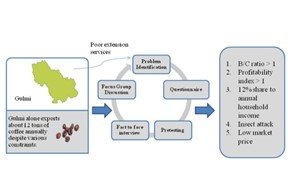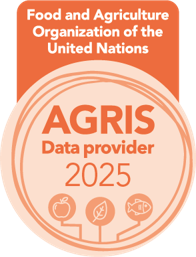Socio-economic analysis of coffee growers in Gulmi district of Nepal
Abstract
Coffee is a major plantation cash crop of hills of Nepal. Gulmi is one of the popular districts for coffee production and export in Nepal. This research is an attempt to assess the production potentiality and profitability of coffee in Gulmi district. This study was carried out in four rural municipalities of Gulmi district namely Ruru rural municipality, Dhurkot rural municipality, Satyawoti rural municipality and Musikot municipality. A total of 100 samples (25 from each rural municipality) were selected using simple random sampling technique. Face to face (FtF) interview method was used to collect primary data using pretested semi-structured questionnaire. The economic indicators of coffee production like gross revenue, gross margin, benefit-cost ratio (BCR) and profitability index (PI) were calculated. BCR and PI were found to be 2.84± 0.59 and 2.50± 1.25, respectively. Gross margin per ropani was calculated to be NRs. 15675.29 ± 7189.72. The contribution of coffee in total household income was 12% in Gulmi showing it to be one of the major influencing commodities. The major production problem was found to be insect attack in the district while the major marketing problem was the low market price. The insights of this research were that coffee has the potentiality to uplift the rural income of Gulmi but at the same time there were poor extension services for coffee growers such that farmers had shown dissatisfaction towards coffee enterprise. Therefore, effective package of production and value chain monitoring should be introduced by the Nepal government in order to address the production and marketing constraints of coffee producers.
Keywords:
Coffee, gross margin, benefit-cost ratio, profitability index, insect pests, market priceDownloads
References
Acharya, B., & Dhakal, S. C. (2014). Profitability and Major Problems of Coffee Production in Palpa District, Nepal. International Journal of Applied Sciences and Biotechnology 2(4), 460-463, https://doi.org/10.3126/ijasbt.v2i4.11252
Acharya, B., Dhakal, S., Pant, S., & D.Dhakal. (2015). Profitability and resource use efficiency of coffee production in Palpa district, Nepal. Technical Publication Thesis Grants, 11-22.
Bastola, U. (2007). Economics of coffee production, processing and marketing: policy implications and prospects of commercialization in Nepal. M.Sc. Thesis. Kathmandu, Bagmati Pradesh, Nepal: Institute of Agriculture and Animal Science, Tribhuvan University.
Bhattarai, C., Bhusal, K., Bhandari, D., Gautam, A., Bhandari, S., & Bhujel, S. (2020). Economic Analysis of Coffee Production in Arghakhanchi and Gulmi Districts of Nepal. Food and Agribusiness Management, 1(1), 39–42, https://doi.org/10.26480/fabm.01.2020.39.42
Central Bureau of Statistics (CBS) (2017). Statistical Year Book 2017. Central Bureau of Statistics. Retrieved from https://cbs.gov.np
Chaudhary, S., & Bastakoti, N. (2021). Money from coffee cherry skins. The Kathmandu Post. https://kathmandupost.com/columns/2021/12/23/money-from-coffee-cherry-skins
Dhakal B. (2004). Coffee Manual. Kathmandu, National Tea and Coffee Development Board.
Department of Agriculture (DoA) (2017). Statistical Information On Nepalese Agriculture, Ministry of Agriculture and Livestock Development.
FAO. (2005, August). Arabica coffee manual for Lao-PDR. Retrieved February 11, 2021, from Food and Agriculture Organization: http://www.fao.org
Karki, Y.K., Regmi, P.P. & Thapa, R.B. (2018). Coffee Production in Kavre and Lalitpur Districts, Nepal. Journal of Nepal Agricultural Research Council 4, 72–78, https://doi.org/10.3126/jnarc.v4i1.19692
Kattel, R. R., Jena, P. & Grote, U. (2009). The impact of coffee production on Nepali smallholders in the value chain. Institute of Environmental Economics and World Trade, Leibniz Universitate. Hannover, Germany.
Khanal, A. P., Khanal, S., Dutta J. P., Dhakal S. C. & Kattel R. R. (2019). An assessment of factors determining the productivity of coffee in western hills of Nepal. International Journal of Agricultural Sciences and Veterinary Medicine 7(2), 11–17, Retrieved from https://www.researchgate.net/publication/333479102%0AAn
Luitel, G. (2017). Value Chain Analysis of Coffee Production in Central Nepal. MSc. Thesis.
Ministry of Agriculture and Livestock Development (MoALD) (2021). Krishi Diary. Lalitpur, Ministry of Agriculture and Livestock Development.
National Tea and Coffee Development Board (NTCDB) (2021). Nepali Coffee. National Tea and Coffee Development Board. Retrieved from https://www.teacoffee.gov.np/
Nyaupane, M. P. (2018). 29 tons of coffee exported from Gulmi and Palpa. MyRepublica. https://myrepublica.nagariknetwork.com/news/29-tons-of-coffee-exported-from-gulmi-palpa/
Pandit, J. (2008). Export potentiality of organic coffee production in Nepal. M.Sc. Thesis.
Paudel, M, & Parajuli, K. (2020). Constraints and Determinants of Coffee Processing Methods in Gulmi District, Nepal. International Journal of Applied Sciences and Biotechnology 8(3), 368-373, https://doi.org/10.3126/ijasbt.v8i3.31565
Poudel, K. L., Poudel, A., Nepal, B. D., Sugimoto, Y., Yamamoto, N. & Nishiwaki, A. (2009). Capital Budgeting Analysis of Organic Coffee Production in Gulmi District of Nepal. University of Miyazaki. Faculty of Agriculture. Department of Environment and Resource Sciences, Interdisciplinary Graduate School for Agriculture and Engineering. Laboratory of Agricultural Economics.
Postgraduate Student Society (PSS) (2004). Postgraduate Student Society. Krishi Sandesh.
Sharma, G.P., Pandit, R., White, B. & Polyakov, M. (2015). The income diversification strategies of smallholder coffee producers in Nepal (No. 1784-2016-141876). https://doi.org/10.22004/ag.econ.207693
Sharma, S., Dhakal, C. K., Ghimire, B. & Rijal, A. (2016). Economic Significance of Coffee (Coffeea arabica) Production in Parbat District of Nepal. International Journal of Agricultural Management and Development 6(2), 123-130.
Shrestha, P. (2014). Taking Nepali Coffee To The World. Retrieved from http://ventureplus.com.np
Shrestha, P. M. (2004). Role of Coffee as a cash crop to uplift the livelihood of farmers in the mid-hills of Nepal. In: Proceedings of the third national horticultural seminar on environment protection and poverty reduction through horticulture development April, 18-19, 2004, 57-63.Nepal Horticulture Society. Kathmandu, Nepal.
Tiwari, K.P. (2010). Agricultural policy review for coffee promotion in Nepal. Journal of Agriculture and Environment 11, 138-147, https://doi.org/10.3126/aej.v11i0.3661
Tuladhar, A. & Khanal D. R. (2018). Coffee production in Nepal-a brief review. In II International Symposium on Beverage Crops 1274, 161-166, https://doi.org/10.17660/ActaHortic.2020.1274.21

Published
How to Cite
Issue
Section
Copyright (c) 2022 Agriculture and Environmental Science Academy

This work is licensed under a Creative Commons Attribution-NonCommercial 4.0 International License.

